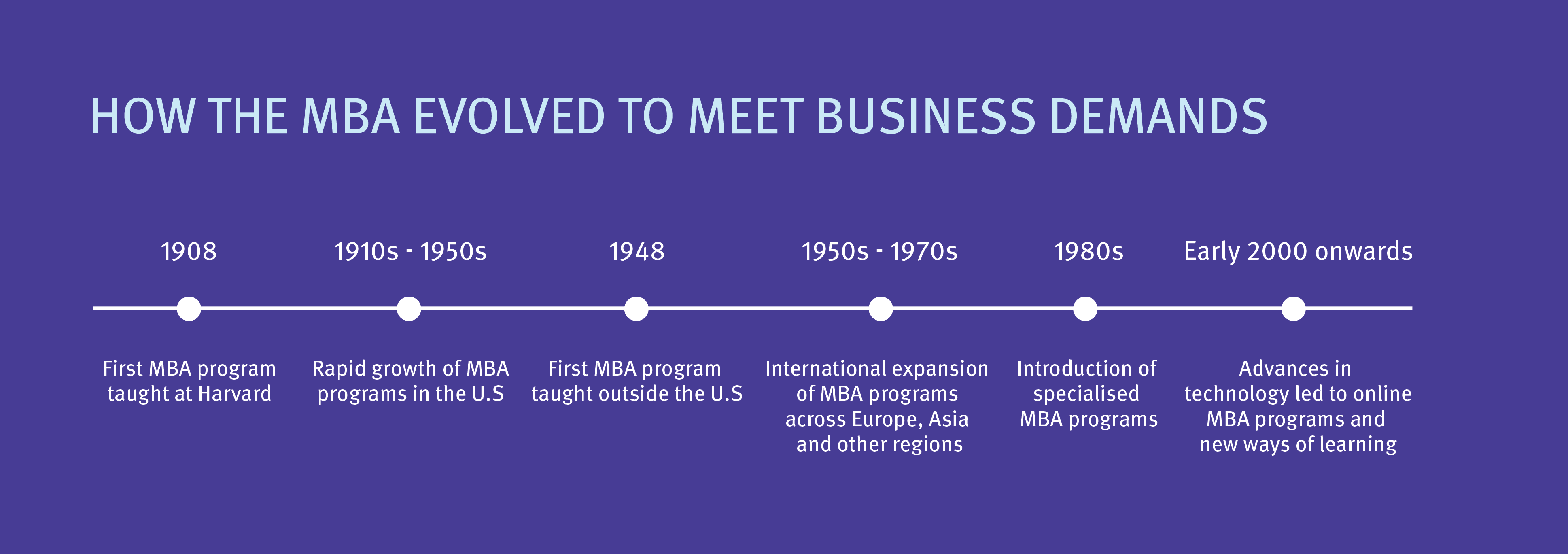How the MBA program evolved to meet business demands
Today, a Master of Business Administration (MBA) helps you build strategic business knowledge and skills that can advance your career into senior leadership. It remains the most popular management degree, respected by employers and offered by business schools all over the world.
What did the MBA look like when it first launched? How has it changed in the last century? In this blog, we will take you through the journey of how the MBA evolved to meet business demands.

Origins
In the early 20th Century, the industrial revolution occurred. Companies were assigning manufacturing processes to machines and the business world was looking for professionals who were educated in financial and management best practices to deliver maximum profit. The first MBA was launched in 1908 at the Harvard Graduate School of Business Administration (known today as Harvard Business School). The curriculum had a scientific approach to management with a focus on business strategy, finance, and operations.
The value of business education was recognised and for several decades following 1908 many other American universities (such as Wharton and Stanford) launched their own business schools and MBA programs. As companies expanded into international markets and new ventures, the MBA started to blend academic theories with strategic planning and real-world business scenarios.
In 1948, the first MBA program outside the United States was taught at the University of Western Ontario in Canada. From the 1950s to the 1970s, the popularity of the MBA spread across Europe, Asia and other regions.
Students
When the MBA degree was first introduced in the United States, it was studied mainly by recent bachelor’s graduates without any work experience. Today, it’s more common to have at least 3-5 years of work experience before enrolling. With the international expansion of the MBA and advances in technology, students of different ages and cultures from around the world can study MBA programs from renowned business schools.
Curriculum changes
- Core purpose
The core purpose of the MBA is the same today as it was in 1908 – to provide a holistic management education, however, the curriculum has evolved alongside a changing business environment.
- Environmental and social awareness
The growing awareness of environmental sustainability and social responsibility has brought greater attention to business ethics and environmental management. Topics related to the environmental and social impacts of business have been integrated into MBA programs to cultivate leaders who can make ethical and equitable decisions.
- Tech-focused subjects
As the internet was not available for public use until the 1980s, during most of the 20th century, businesses would have had a physical store or office. The digital age brought on new ways of running a business online. The MBA started to include more tech-focused subjects such as digital marketing, business analytics, information systems and artificial intelligence (AI).
- Soft skills
Today, theoretical approaches and technical knowledge are now taught alongside the development of soft skills such as communication skills and emotional intelligence to create leaders who are not only smart but can inspire vision and collaboration. With the rise in globalisation, the MBA curriculum expanded to enhance cross-cultural understanding and taught students how to navigate and adapt to international markets.
- Growth in specialisations
The earlier MBA programs focused on strategy, finance and operations. Although, these areas are still taught today, the demand by companies for more focused knowledge in the 1980s led to the rise of MBA specialisations. Today, students can add a specialisation to their MBA in a wide of areas such as project management, entrepreneurship, health service management, and tourist and hospitality leadership to expand their career opportunities.
New technology
- New business models
From the early 2000s, the rapid public adoption of the internet and AI allowed for innovative ways of running a business. For example, people could lease their homes on Airbnb and everyone who had a car and a license could be a taxi driver with Uber. Every day, there would be new startups or mobile applications. Social media became an essential part of the business toolkit.
Business schools had to update their programs so that MBA graduates of the 21st century would be versatile, adaptable, and tech-savvy.
Flexible study
The MBA was traditionally offered as a full-time degree on campus. In the early 2000s, some MBA programs were offered online and part-time to cater for professionals who needed to balance personal and work commitments.
The COVID-19 pandemic added to the popularity of online MBAs and hybrid models of study and new technology such as video conferencing and online learning management systems enabled this to happen. Students today can customise and stagger their MBA study schedule to enjoy greater flexibility and a better study/work-life balance.
- Generative AI
Today, the MBA education is being significantly shaped by Generative AI (GenAI). Both industry and academia are recognising the increasing demand and the gaps in graduate skills for digital literacy and leadership. According to McKinsey’s 2023 Global Survey on reskilling, 87% of executives reported experiencing skill gaps in these areas. In response, many higher education institutions are incorporating GenAI into the curriculum and offering specialisations to bridge this gap.
Listen to our Kaplan Community Podcast where we speak with Michael Wang - Investment Analyst, Data Scientist and AI Consultant - about how AI is transforming the way we work now and into the future.
Innovative teaching methods
- Experiential learning
Today’s MBA has moved on from formal lectures. Experiential learning which means ‘learning by doing’ has become the preferred approach.
Experiential learning can involve completing internships and attending networking and industry events to gain practical experience and insight. Traditional assignments (e.g. essays) and final exams are gradually being replaced by team projects and individual assessments that test a student’s practical business knowledge. Collaborative assignments are included to foster teamwork, communication and leadership skills which reflect the soft skills students will need in the real business world.
- Online systems and resources
Before, everything was submitted and received on paper. Learning management systems are now online. Students can submit their work and communicate with their lecturers via an online portal. Lecturers can track their students’ progress in real time and provide feedback, offer new challenges to students who are excelling or use gamification. Business schools are providing different online formats (e.g. audio files, quizzes, infographics, webinars etc) to cater for different learning styles and utilising technology to deliver a more engaging and collaborative learning experience (e.g. Virtual Reality, online whiteboards).
- Generative AI
GenAI has impacted the way we teach and learn the MBA in many ways. AI tools such as ChatGPT can help students structure and write essays, summarise journal articles, and brainstorm ideas. Lecturers can use ChatGPT to help them write teaching plans, assessment tasks, reports and policies.
Gen AI has its strengths but also its weaknesses and higher education providers need to have written policies to educate their students on the correct use of Gen AI applications. AI is transforming education, but its true value lies in enhancing human capabilities, not replacing them.
- Globalisation
Business schools used to have one campus or kept knowledge-sharing within the faculty. Globalisation has led to international collaboration with other schools, multiple campuses that students can transfer between, study-abroad and exchange opportunities, and internship and mentoring programs with external organisations. Business schools have LinkedIn profile pages and other social media platforms that connect alumni and business professionals together.
- Lifelong learning
Previously, students mainly accessed support during the length of their MBA degree. Today, business schools connect and offer support to their students after graduation and throughout their careers. Initiatives can include free online courses, industry events and networking opportunities.
At Kaplan Business School, our alumni enjoy many benefits including lifetime access to live online classes of the course from which they graduated from (which equips them with updated industry knowledge), lifelong career coaching and invitations to our workshops and industry events.
Develop your leadership skills and invest in your career. Our MBA is the most popular MBA course in Australia* and will provide you with the expertise and practical skills to succeed in the world of business. Read our Ultimate Guide to doing an MBA in Australia to discover how an MBA can help advance your career.
*MBA News 2022









